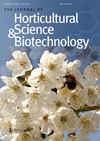Dry-matter production and partition in diploid, triploid and tetraploid tea
IF 2.1
4区 农林科学
Q2 HORTICULTURE
Journal of Horticultural Science & Biotechnology
Pub Date : 1999-01-01
DOI:10.1080/14620316.1999.11511144
引用次数: 20
Abstract
SummaryThe effects of polyploidy on yield, total dry-matter production and partitioning of tea were studied in diploid (23), triploid (33) and tetraploid (43) tea (Camellia sinensis). Although increased ploidy depressed yield significantly (P<0.05), significant differences in productivity were noted among genotypes of the same ploidy level and some triploids even outyielded some diploids which indicated the potential for selecting and/or developing high yielding polyploid clones. After 60 months of growth, the clones had accumulated 20±53 tonnes of dry matter per hectare. Diploids accumulated significantly higher total biomass than the polyploids. Between 25 and 40% of total accumulated dry matter was partitioned into leaves. Polyploids had a large proportion of unplucked leaves which indicated that their productivity could be improved by plucking older leaves with the bud (coarse plucking) or by more frequent plucking. Between 13 and 32% of the total dry matter was partitioned into the root system. The h...二倍体、三倍体和四倍体茶叶干物质的产生和分化
摘要以二倍体(23)、三倍体(33)和四倍体(43)茶为材料,研究了多倍性对茶叶产量、总干物质产量和分配的影响。虽然增加的倍性显著降低了产量(P<0.05),但在相同倍性水平的基因型中,产量差异显著,一些三倍体甚至超过一些二倍体,这表明选择和/或培育高产多倍体的潜力。生长60个月后,无性系每公顷积累干物质20±53吨。二倍体积累的总生物量显著高于多倍体。总积累干物质的25 ~ 40%被分配到叶片中。多倍体的未拔叶比例较大,表明其产量可以通过粗拔或频繁的拔叶来提高。总干物质的13% ~ 32%被分配到根系。h……
本文章由计算机程序翻译,如有差异,请以英文原文为准。
求助全文
约1分钟内获得全文
求助全文
来源期刊
CiteScore
3.90
自引率
5.30%
发文量
67
审稿时长
3 months
期刊介绍:
The Journal of Horticultural Science and Biotechnology is an international, peer-reviewed journal, which publishes original research contributions into the production, improvement and utilisation of horticultural crops. It aims to provide scientific knowledge of interest to those engaged in scientific research and the practice of horticulture. The scope of the journal includes studies on fruit and other perennial crops, vegetables and ornamentals grown in temperate or tropical regions and their use in commercial, amenity or urban horticulture. Papers, including reviews, that give new insights into plant and crop growth, yield, quality and response to the environment, are welcome, including those arising from technological innovation and developments in crop genome sequencing and other biotechnological advances.

 求助内容:
求助内容: 应助结果提醒方式:
应助结果提醒方式:


